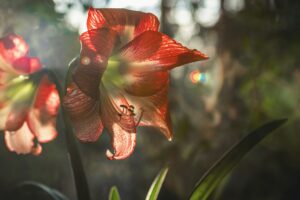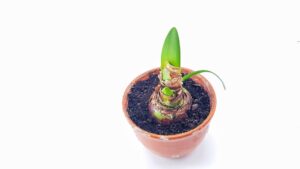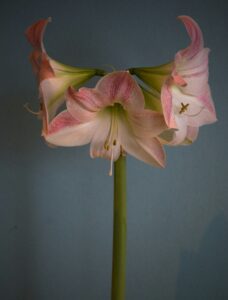Amaryllis Flower a perennial flowering plant, captivates with its stunning and majestic blossoms, adding a touch of grandeur to gardens and indoor spaces alike. Renowned for its bold, trumpet-shaped flowers and vibrant colors, the Amaryllis stands as a symbol of beauty and sophistication. This ornamental plant, belonging to the Amaryllidaceae family, is cherished for its remarkable presence and the ease with which it graces any environment.
Amaryllis species are native to South Africa and are particularly prevalent in the western and southern regions of the continent. However, they have become popular ornamental plants worldwide. The Amaryllis carries various symbolic meanings, often associated with pride, determination, and radiant beauty. Its majestic presence has inspired poets and artists throughout history, contributing to its cultural significance as a symbol of splendor and elegance.

The Amaryllis is renowned for its large, trumpet-shaped flowers that can reach sizes of up to 8 inches in diameter. These showy blooms come in various colors, including shades of red, pink, orange, white, and even bi-color varieties. Each Amaryllis flower can last for several weeks, providing an extended period of visual delight. The longevity of the blooms adds to the appeal of the plant as a decorative and long-lasting flowering species. Each flower carries an undeniable allure, often featuring intricate patterns and contrasting tones.
The Amaryllis boasts tall, sturdy stems that bear the weight of its blossoms with grace. These stems contribute to the plant’s imposing presence, making it a focal point in gardens or indoor settings. Amaryllis plants grow from bulbs, which store energy for the plant’s growth and flowering. The bulb is a reservoir of vitality, allowing the Amaryllis to produce impressive blooms season after season.
While the Amaryllis thrives outdoors in suitable climates, it also adapts well to indoor cultivation. This versatility makes it a popular choice for both garden landscapes and interior décor. Amaryllis typically blooms during the winter months, gracing the surroundings with its spectacular flowers when many other plants are dormant. This seasonal charm adds to its allure as a winter-blooming beauty.

Amaryllis plants contain substances that can be toxic to pets, particularly cats and dogs, if ingested. Pet owners should exercise caution and keep Amaryllis plants out of reach of their furry friends.
Cultivars of Amaryllis Flower
Amaryllis boasts a wide range of cultivars and varieties, each offering unique colors, patterns, and characteristics. Here are some popular cultivars of Amaryllis:
‘Red Line’: One of the most iconic Amaryllis cultivars, ‘Red Lion’ features large, brilliant red flowers with white throats. Its striking color and classic beauty make it a favorite for holiday decorations.

‘Apple Blossom’: This cultivar presents delicate, soft pink flowers with white highlights, resembling the gentle hues of apple blossoms. ‘Apple Blossom’ adds a touch of elegance to any setting.

‘Stargazer’: ‘Stargazer’ is known for its stunning star-shaped blooms and vibrant colors. The petals often display a mix of red, pink, and white, creating a captivating visual effect reminiscent of a starlit night.

‘Minerva’: Featuring bold red petals with white margins, ‘Minerva’ is a captivating Amaryllis cultivar. The contrasting colors and large flower size make it a popular choice for both indoor and outdoor displays.
‘Picotee’: ‘Picotee’ Amaryllis is recognized for its unique edging pattern on the petals. The main color of the flower contrasts with a distinct, lighter-colored edge, creating a striking and eye-catching appearance.
‘Charisma’: This cultivar showcases rich, velvety red flowers with white streaks and edges. ‘Charisma’ Amaryllis adds a touch of drama and sophistication to floral arrangements.
‘Nymph’: ‘Nymph’ is celebrated for its elegant, soft-pink blooms with a subtle white throat. The graceful appearance of ‘Nymph’ makes it a popular choice for creating charming and romantic settings.
‘Alfresco’: Boasting a cheerful and vibrant appearance, ‘Alfresco’ Amaryllis features bright red flowers with a white star-shaped center. Its lively color combination is perfect for adding a festive touch to holiday displays.
‘Double King’: As the name suggests, ‘Double King’ produces double-petaled flowers, creating a lush and full appearance. The petals are often a deep, velvety red, adding a sense of luxury to the display.
‘Lagoon’: ‘Lagoon’ Amaryllis is prized for its enchanting blue-green hues. The flowers feature a captivating blend of greenish-blue tones, making ‘Lagoon’ a unique and sought-after cultivar.
‘White Christmas’: For those seeking a classic and elegant look, ‘White Christmas’ Amaryllis fits the bill. It produces large, pure-white blooms, making it an ideal choice for winter and holiday arrangements.

These cultivars represent just a glimpse of the diverse and captivating world of Amaryllis varieties. With their stunning colors and unique characteristics, Amaryllis cultivars continue to be cherished by enthusiasts and floral enthusiasts alike.
Sunlight Requirement
Amaryllis flowers thrive in bright, indirect sunlight. Amaryllis prefers a location with partial shade. Ensure that the plant receives at least six hours of indirect sunlight daily. In regions with mild climates, it can tolerate some morning sun but should be protected from intense afternoon sunlight.

When grown indoors, place amaryllis in a location where it receives bright, filtered sunlight. A sunny windowsill that provides indirect sunlight is ideal. Avoid placing the plant in direct, harsh sunlight, as this can lead to leaf burn. If growing amaryllis in a container indoors, consider rotating the pot periodically to ensure even exposure to sunlight. This helps prevent the plant from leaning towards the light source.
Soil Requirement of Amaryllis Flower
Amaryllis thrives in slightly acidic to neutral soil with a pH range between 6.0 and 7.0. A pH within this range ensures that essential nutrients are readily available to the plant. While amaryllis bulbs store energy for flowering, they benefit from a soil rich in nutrients. Amaryllis prefers well-draining soil to prevent waterlogging, which can lead to bulb and root rot. The soil should allow excess water to drain freely, ensuring that the roots do not sit in water. A quality potting mix for bulbs or a general-purpose mix enriched with organic matter is suitable for containers or pots.

Temperature and Humidity Requirements for Amaryllis Flowers
Amaryllis generally thrives in moderate temperatures. The ideal temperature range for growing amaryllis is between 60°F to 75°F (15°C to 24°C). For optimal blooming, amaryllis prefers temperatures around 70°F to 75°F (21°C to 24°C). Protect amaryllis from frost, and avoid exposing it to temperatures below 50°F (10°C). Amaryllis flower is not particularly sensitive to humidity, providing moderate humidity levels is generally suitable. It can tolerate average indoor humidity levels without significant issues.
Propagation of Amaryllis Flower
Propagation of amaryllis is typically done through bulb offsets or seeds.
Bulb Offsets:
Amaryllis bulbs often produce offsets, smaller bulbs that develop alongside the main bulb. These offsets can be carefully separated and planted to grow into new plants.
Wait until the amaryllis has finished flowering and entered its dormant phase.
Gently remove the bulb from the soil, being cautious not to damage the offsets.
Separate the offsets from the main bulb, ensuring each has some roots attached.
Plant the offsets in fresh, well-draining soil, burying them up to their necks.

Seed Propagation:
Amaryllis can be grown from seeds, but it requires patience as the process is slower compared to offset propagation.
Collect seeds from mature amaryllis pods after flowering. Allow the pods to dry and split open naturally.
Plant the seeds in a seed-starting mix or well-draining potting soil.
Keep the soil consistently moist and provide warmth. Germination may take several weeks.
Once the seedlings are large enough, transplant them into individual pots.
Sowing of Amaryllis Bulb
Choose high-quality, firm bulbs. Larger bulbs often produce more substantial blooms.
Amaryllis can be planted in the fall for winter blooms or in early spring for summer blooms. Indoor cultivation allows for year-round planting.
Plant the bulb with about one-third to one-half of it above the soil surface. The top of the bulb, where the neck meets the base, should be visible.
Use a well-draining pot with drainage holes to prevent waterlogging.
Use a well-draining potting mix. You can create a mix with equal parts of potting soil, perlite, and coarse sand.
Water the bulb thoroughly after planting to settle the soil
Place the potted bulb in a location with bright, indirect sunlight. A sunny windowsill is ideal. During active growth and blooming, provide temperatures around 70°F to 75°F (21°C to 24°C).
Amaryllis typically goes through different stages, including leaf growth, flowering, and dormancy. After blooming, the plant may enter a dormant phase.

Water Requirements of Amaryllis Flower
During the active growing and blooming phases, water the amaryllis consistently. Keep the soil evenly moist but not waterlogged. Before each watering, allow the top inch (2.5 cm) of the soil to dry out. Insert your finger into the soil to check the moisture level. Watering too frequently or letting the soil stay excessively wet can lead to bulb and root rot. When the amaryllis is in its dormant phase, typically after blooming, reduces watering.
Fertilizer Requirements of Amaryllis Flower
Amaryllis plants benefit from regular fertilization to support their growth, blooming, and overall health. Begin fertilizing amaryllis when new growth emerges in the spring. Use a balanced, water-soluble fertilizer with equal amounts of nitrogen (N), phosphorus (P), and potassium (K). A fertilizer labeled as 10-10-10 or similar ratios is suitable. Consider using a specialized bulb or flowering plant fertilizer that provides essential nutrients for bulb development and flowering.

After Flowering Care
Once the flowers have faded and wilted, carefully snip them off at the base of the flower stalk using clean, sharp scissors or pruning shears. This prevents the plant from expending energy on seed production. Keep watering the amaryllis regularly even after flowering. Protect the amaryllis from drafts and sudden temperature changes. Keep the plant in a stable environment to avoid stress. Allow the foliage to continue growing.
After several weeks of active growth, the amaryllis will naturally enter a dormant phase. Reduce watering gradually to allow the soil to dry out. Place the amaryllis bulb in a cool, dark location for about 8 to 10 weeks. This mimics its natural dormancy period. Keep the bulb in a dormant state by withholding water during this time. After the dormancy period, resume watering the amaryllis and bring it back into a well-lit area. Begin fertilizing as new growth emerges, following the regular care routine.
Harvesting of Amaryllis Flower for cut flower
Amaryllis flowers are commonly grown for their striking blooms, and harvesting them for cut flowers can be a delightful way to enjoy their beauty indoors. Allow the amaryllis flowers to reach their full bloom before harvesting. The petals should be fully open, and the colors should be vibrant.
Harvest amaryllis flowers in the morning or evening when temperatures are cooler. Use clean and sharp scissors or pruning shears to make clean cuts. Cut the flower stalk (scape) close to the base of the plant, leaving about 1 to 2 inches (2.5 to 5 cm) of the stalk attached to the bulb. Cut at a 45-degree angle to promote water absorption. Place the harvested amaryllis stalks in a container of lukewarm water as soon as possible. Arrange the cut amaryllis flowers in a vase with fresh water. Consider combining them with other flowers or greenery for a beautiful and diverse floral display.

Problems While Growing Amaryllis Flower
Growing amaryllis flowers can be a rewarding experience, but like any plant, they may face certain issues. Here are some common problems that can occur while growing amaryllis and potential solutions:
No Blooms: Amaryllis may not bloom if they haven’t gone through a proper dormancy period, or they may not have received enough sunlight during the growing season. Allow the plant to go through a dormant phase by reducing watering after flowering. Ensure the amaryllis receives bright, indirect sunlight during the active growth phase.
Tall and Leggy Stalks: Stalks that are tall and leggy may indicate insufficient light. Amaryllis should be placed in a location with bright, indirect sunlight. Move the plant to a brighter location. Rotating the pot occasionally can help promote even growth.
Fungal Diseases: Amaryllis can be susceptible to fungal diseases, especially in humid conditions. This may present as spots on leaves. Ensure good air circulation around the plant. Avoid overwatering and keep the foliage dry. Fungicides may be used if the problem persists.
Bud Blast: Bud blast occurs when flower buds fail to open. This may be due to sudden changes in temperature, drafts, or insufficient sunlight. Place the amaryllis in a stable environment with consistent temperatures. Avoid placing it near drafty windows or heaters.

Soft or Rotted Bulbs: Soft or rotted bulbs can result from overwatering or poorly drained soil. Allow the soil to dry out between waterings. Ensure the pot has drainage holes, and use a well-draining potting mix.
Regular monitoring, proper care, and prompt action to address issues can help keep your amaryllis healthy and vibrant. Adjusting care practices based on the specific needs of the plant can contribute to successful amaryllis cultivation.
Ornamental Uses of Amaryllis Flowers
Amaryllis flowers are not only known for their vibrant and large blooms but also for their ornamental value. Here are some ornamental uses of amaryllis flowers:
Indoor Decoration: Amaryllis flowers are popular for indoor decoration, especially during the winter months. Their bold and colorful blooms add a touch of elegance to homes, offices, and other indoor spaces.

Festive Displays: Amaryllis is often associated with festive occasions, and their blooming season coincides with holidays such as Christmas. The flowers are used in festive arrangements and centerpieces, contributing to the seasonal decor.
Cut Flower Arrangements: Harvested amaryllis flowers are commonly used in cut flower arrangements. Their tall stems and large, trumpet-shaped blooms make them striking focal points in bouquets and floral displays.
Gifts and Presents: Amaryllis bulbs or potted amaryllis plants are popular gift choices. Gifting them during the holiday season or as a gesture of celebration is common, as the flowers symbolize beauty and pride.
Table Centerpieces: Amaryllis flowers are often featured in table centerpieces for events, weddings, and special occasions. Their size and vibrant colors make them stand out and capture attention.
Gardening and Landscaping: In regions where amaryllis can be grown outdoors, they are used in landscaping to enhance garden beds and borders. The tall flower stalks create vertical interest, and the blooms provide a burst of color.
Forcing Blooms Indoors: Amaryllis bulbs can be forced to bloom indoors, allowing individuals to enjoy their beauty even in regions where outdoor cultivation is challenging. This is a popular practice during the winter months.
Whether used as a centerpiece for a festive occasion, a thoughtful gift, or an indoor decorative element, amaryllis flowers contribute to a visually stunning and vibrant display, making them a cherished ornamental plant.



1 comment
I’ve been following this blog for years and it’s amazing to see how much it has grown and evolved Congratulations on all your success!